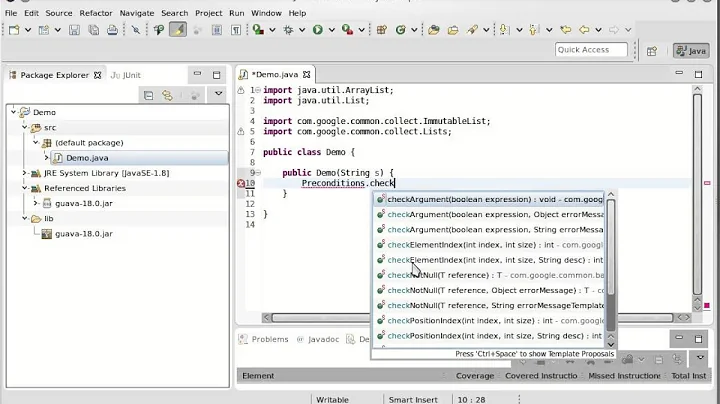Guava ImmutableMap Builder syntax
No, they are identical. The reason for the first syntax is that it makes a nice one-liner.
The reason for the second syntax is the you might have a loop or other flow control, you may need to pass the Builder around.
For example:
public static void main(final String[] args) throws Exception {
final ImmutableList.Builder<Integer> lb = ImmutableList.builder();
for (final String arg : args) {
lb.add(Integer.parseInt(arg));
}
}
And before you say it, yes a FluentIterable would probably be better in this case - but it's just an example.
Related videos on Youtube
Durandal
Full Stack engineer and Data Consultant. I work mostly in Java, Groovy, Kotlin, & Python; occasionally in PHP & Ruby. I spend a fair amount of time using R as well to facilitate my data science work. Open Source advocate. I dig data viz stuff as well.
Updated on July 09, 2022Comments
-
 Durandal almost 2 years
Durandal almost 2 yearsI've been using Guava's
ImmutableMapwith aBuilderfor awhile without giving much thought to how/why it works. I've been using the builder in the way described by the Javadoc:ImmutableMap<String, Integer> WORD_TO_INT = new ImmutableMap.Builder<String, Integer>() .put("one", 1) .put("two", 2) .put("three", 3) .build();I've also seen examples elsewhere on SO of this syntax:
ImmutableMap<String,Integer> myMap = ImmutableMap.<String, Integer>builder() .put("one", 1) .put("two", 2) .put("three", 3) .build();Both seem to produce the exact same result.
A quick glance at the
ImmutableMapsource shows that the staticbuilder()call in the 2nd example returns:new Builder<K, V>()There doesn't appear to be any functional difference between the two methods.
Is there any difference under the hood? Any reason to prefer one or the other?
EDIT: Adding bytecode difference.
The bytecode generated is almost identical except for one line:
Method 1(
Builder<K,V>):static {}; 0 new com.google.common.collect.ImmutableMap$Builder [12] 3 dup 4 invokespecial com.google.common.collect.ImmutableMap$Builder() [14] 7 ldc <String "key1"> [17] ........Method 2:(
<K,V>builder())static {}; 0 invokestatic com.google.common.collect.ImmutableMap.builder() : com.google.common.collect.ImmutableMap$Builder [12] 3 ldc <String "key1"> [18] ........After that they're pretty much the same, the first line being different makes sense given the source differences, but I'm not sure why the first one calls
dupand the second doesn't. -
 Durandal over 10 yearsAny idea why the
Durandal over 10 yearsAny idea why thedupshows up in the bytecode for the first one? I don't know enough about bytecode to know if that's typical or not. -
 Boris the Spider over 10 years@MagicMan if you look at the source code you will see that the methods are different - I'm not surprised that the bytecode is different. As to why it duplicates the value, I'm not sure.
Boris the Spider over 10 years@MagicMan if you look at the source code you will see that the methods are different - I'm not surprised that the bytecode is different. As to why it duplicates the value, I'm not sure. -
 Durandal over 10 yearsAhh, as long as there isn't any big difference I won't worry. Example makes it clear how I should be using it, thanks!
Durandal over 10 yearsAhh, as long as there isn't any big difference I won't worry. Example makes it clear how I should be using it, thanks! -
 Vladimir Matveev over 10 years@MagicMan, you didn't provide full bytecode listing, but I believe that there is something like
Vladimir Matveev over 10 years@MagicMan, you didn't provide full bytecode listing, but I believe that there is something likeinvokespecial ...ImmutableMap$Builder.<init>()afterdupin the first example. This is exactly whydupis needed. In Java construction is two-phase process: first, new memory is allocated vianew, and then a constructor method (<init>) is called on that memory. Soduped stack element is consumed by the constructor. -
 Durandal over 10 years@VladimirMatveev Ahh, sorry, just edited and added that next line. You are correct, it was indeed
Durandal over 10 years@VladimirMatveev Ahh, sorry, just edited and added that next line. You are correct, it was indeedinvokespecial....









